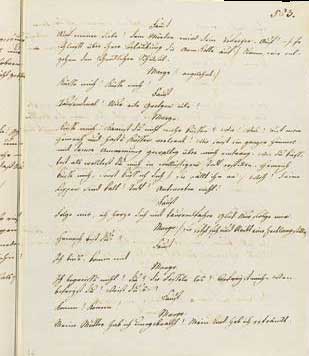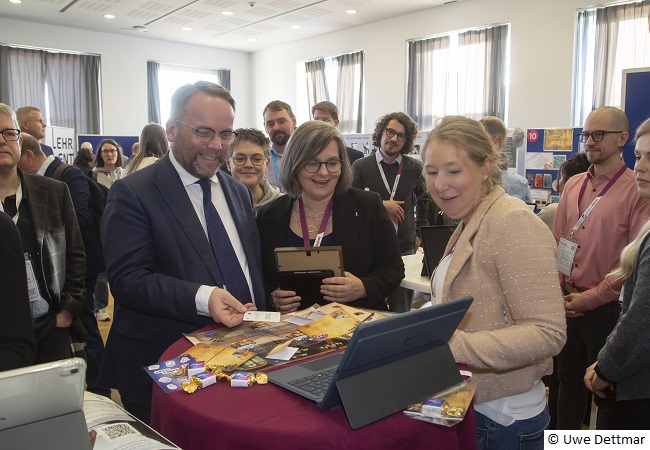In 1772, Johann Wolfgang Goethe began his opus magnum. The material, which would initially go down in literary history as the “Urfaust”, accompanied him until the end of his life. An equally opulent project, the “Digital Edition of Faust”, compiled under the direction of Goethe expert Professor Anne Bohnenkamp-Renken, sheds light on the path to completion of “Faust, Part Two”.
When exactly Goethe began to occupy himself with the material for Faust has so far remained a mystery even to experts. “Goethe probably first started thinking about Faust during his student days,” says Anne Bohnenkamp-Renken, Professor of German Studies at Goethe University Frankfurt and director of the Freie Deutsche Hochstift about the state of research [editor’s note: The Freie Deutsche Hochstift is a non-profit research institution and one of Germany’s oldest cultural institutes]. What is certain, however, is that it was in 1772 in Frankfurt that he began putting down on paper what would later be known as the “Urfaust”.
Johann Wolfgang Goethe worked on the Faust material for almost his entire adult life. He abridged, augmented, polished and rewrote his various texts. He remained in constant contact with his contemporaries throughout; their views and suggestions also fed into his work. The creative process was a virtually endless assemblage of texts and annotations by the poet’s hand and that of others.
Making this assemblage accessible is the “Digital Edition of Faust” database, which first went online in 2018, and was compiled under the direction of Faust expert Anne Bohnenkamp-Renken, Professor Fotis Jannidis, computer philologist at Julius-Maximilians-Universität of Würzburg, and Dr. Silke Henke from the Goethe- und Schiller-Archiv in Weimar (the oldest literary archive in Germany and the central archive for German-language literature and culture of the 18th and 19th century). Anne Bohnenkamp-Renken’s doctoral thesis had already dealt with what are known as the paralipomena to Goethe’s “Faust”, that is, the texts and text fragments that Goethe wrote but did not publish. These include both scribbled notes on envelopes or receipts, as well as fair copies of entire scenes. However, Bohnenkamp-Renken was unable to take all the manuscripts that document Goethe’s work on “Faust” into consideration in her thesis.
Claim to completeness
The “Digital Edition of Faust” aspires to be complete. That is quite something given that hardly any other poet has left as much textual material behind as Goethe. This edition has documented and made available everything – from the smallest snippets of text to the whole tragedy – from the “Urfaust” to “Faust, Part Two”, only excerpts of which were published during Goethe’s lifetime. The results are accessible online at www.faustedition.net.

However, the legacies from the early years are modest. So much is known: Goethe took the first version, known as the “Urfaust”, with him to Weimar and presented it there. Important scenes were not yet rhymed; the text is attributed to the Sturm und Drang period. It has survived solely as a copy owned by Luise von Göchhausen and the manuscript only emerged in the 19th century, when Goethe was no longer alive.
By contrast, records from later versions speak volumes. In 1790, “Faust. A Fragment” was published, in 1808, “Faust, Part One”, and finally, in 1832 – after the poet’s death – “Faust, Part Two”. Over the course of time, the poet himself collected more and more of his notes and correspondence. “From 1814 onwards, Goethe saw himself as a historical figure, and began collecting everything to do with his work,” says Bohnenkamp-Renken. “He was one of the inventors of the poet’s archive.” Looking at it this way, the “Digital Edition of Faust” is in a way a continuation of the process Goethe himself begun.
The online edition includes edits and contextualizations to the various printed versions as well as a transcription of the handwritten sheets into readable script. “Even literary scholars cannot always read Goethe’s handwriting,” explains Bohnenkamp-Renken. Students, teachers, experts – anyone interested can examine the different versions of individual text passages and track the poet’s work, which spanned over 60 years.
What Goethe preferred not to see in print
One important goal of the “Digital Edition of Faust” is to give a glimpse into the way Goethe worked on his texts. Far more than merely an archive, the online edition also places the texts in a “genetic context” from a philological perspective. Anyone interested in Goethe’s work can easily lose themselves in its windings and weavings, laugh at many a witty aperçu and allow themselves to be transported back to the time when the famous lines were written. It is quite fascinating to trace how Goethe struggled to find the right words until he came up with the variant that has meanwhile often become a figure of speech. Did Faust study “Juristerey und Medizin” [jurisprudence and medicine] or “Medizin und Juristerey” [medicine and jurisprudence]? We know which variant Goethe ultimately chose. While the issue here was more one of poetic form, comparing the published and unpublished versions of Gretchen’s song at the spinning wheel makes for deeper insights: whereas in the early Frankfurt version Goethe puts the words “Mein Schoos! Gott! drängt / sich nach ihm hin” [“My womb! God! It yearns towards him”] into Margarete’s mouth, he “defused” this part in the printed edition. Gretchen now says: “Mein Busen / drängt sich nach ihm hin” [“My bosom presses towards him”]. Of course, the digital edition also includes the infamous Satanic mass, which is missing from the published version. Goethe did not want to subject his audience to the drastically vulgar scene – saving it “for the future” instead.
Parallel to the digital edition going online, a facsimile of the last large fair copy of “Faust, Part Two” has also been published, as well as the text constituted from all the records (Wallstein Verlag 2018). So, the hybrid edition is also a “historical-critical edition” in the strict sense of the term, that is, one which presents the most authentic version of a text. As of now, the “Digital Edition of Faust” is not yet completely finished and version 1.3 RC only recently released. It contains various additions, including detailed documentation of the types of paper Goethe used, with illustrations and the locations of all the watermarks.

Still unrhymed, but with a lot of drama. In the “Urfaust” dungeon scene Goethe has Gretchen call out: “Küsse mich! Kannst du nicht mehr küssen? Wie! Was! Bist mein Heinrich und hasts Küssen verlernt! Wie sonst ein ganzer Himmel mit deiner Umarmung gewaltig über mich eindrang! Wie du küsstest, als wolltest du mich in wollüstigem Todt ersticken! Heinrich, küsse mich, sonst küss ich dich sie fällt ihn an Weh! deine Lippen sind kalt! Todt! Antworten nicht!” [“Kiss me! Canst no longer do it? How! What! Thou art my Heinrich and hast unlearned thy kissing! When else the might of a whole heaven invaded me with your embrace! And thou didst kiss, as thou wouldst suffocate me in wanton death! Heinrich, kiss me or I’ll kiss thee! (She throws herself at him.) Ah, woe! Thy lips are chill! Dead! They respond not!”]
Faust anticipated today’s debates
The question was recently raised whether “Faust” is a literary must-read for German high school students. Anne Bohnenkamp-Renken does not believe making the work compulsory is expedient. That being said, she has no doubt whatsoever that the text is as current today as it has always been: “‘Faust, Part Two’ especially addresses many issues and problems that are preying on our minds today. Whether inflation, the destruction of nature or the question of how we can use renewable energies – Goethe very closely observed the eve of industrialization, the age he was living in,” she says.
F a u s t.
Auf meine Liebe! Dein Mörder wird dein Befreyer. Auf! — Er schliesst über ihrer Betäubung die Armkette auf. Komm, wir entgehen dem schröcklichen Schicksaal.
M a r g r e t e angelehnt
Küsse mich! Küsse mich!
F a u s t.
Tausendmal! Nur eile, Gretgen, eile!
M a r g r e t e.
Küsse mich! Kannst du nicht mehr küssen? Wie! Was! Bist mein Heinrich und hasts Küssen verlernt! Wie sonst ein ganzer Himmel mit deiner Umarmung gewaltig über mich eindrang! Wie du küsstest, als wolltest du mich in wollüstigem Todt ersticken! Heinrich, küsse mich, sonst küss ich dich sie fällt ihn an Weh! deine Lippen sind kalt! Todt! Antworten nicht!
F a u s t.
Folge mir, ich herze dich mit tausendfacher Glut. Nur folge mir!
M a r g r e t e, sie setzt sich und bleibt eine Zeitlang stille
Heinrich, bist dus?
F a u s t.
Ich binns, komm mit!
M a r g r e t e.
Ich begreiffs nicht! Du? Die Fesseln los! Befreyst mich. Wen befreyst du? Weist du’s?
F a u s t.
Komm! Komm!
M a r g r e t e.
Meine Mutter hab ich umgebracht! Mein Kind hab ich ertränckt.
Page 93 of the ‚Urfaust‘ (Goethe und Schiller Archive, GSA 25/W 2890)









